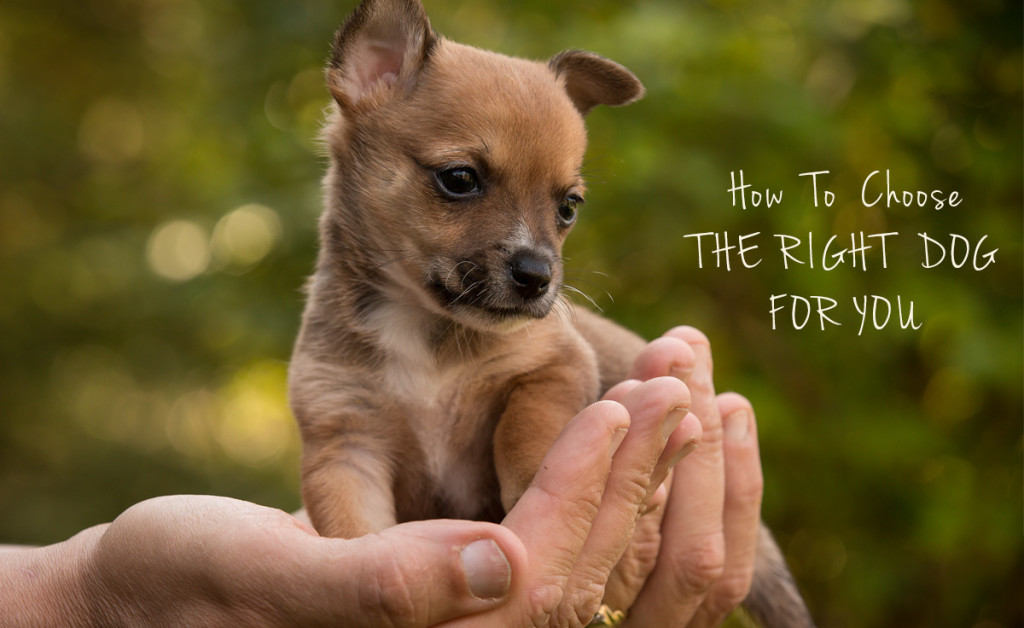
Deciding what breed of dog to get and knowing which breed of dog best matches your daily life will probably be one of the most important decisions of dog ownership. The American Kennel Club recognizes over 160 breeds of dogs. That means that you have over 160 choices to choose from.
With all those choices, how do you know how to choose the right dog for you? Below are some guidelines to consider before adopting your next four-legged best friend. You can also take a quiz to help guide you to choosing the right dog.
Temperament
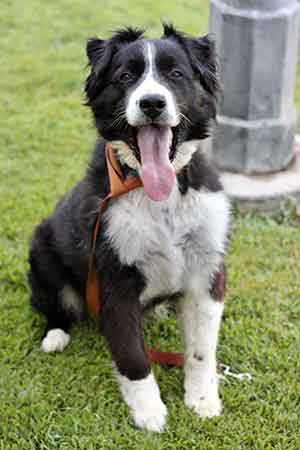 You are going to be living with this dog for a long time and you will need to make sure they have a personality you can live with. Do you want a dog that is more or less active? A dog that can easily be trained or one that’s strong willed? A dog that is friendly with everyone or one that strictly loyal to the family? Laid-back breeds of dogs include bulldogs, pugs and bullmastiffs. Easily trained breed of dogs would be Australian cattle dogs, border collies, golden retrievers, papillons and rottweilers.
You are going to be living with this dog for a long time and you will need to make sure they have a personality you can live with. Do you want a dog that is more or less active? A dog that can easily be trained or one that’s strong willed? A dog that is friendly with everyone or one that strictly loyal to the family? Laid-back breeds of dogs include bulldogs, pugs and bullmastiffs. Easily trained breed of dogs would be Australian cattle dogs, border collies, golden retrievers, papillons and rottweilers.
Time Commitment
Consider how much time you and your family have to commit to your dog. Are you gone during most the day, only home during dinner time? Are you home most of the day? Are you never home? If you have limited time at home you might consider a breed that doesn’t mind being home alone or one that doesn’t get bored easily. For example, beagles bore easily and will damage things trying to free themselves from boredom.
Size
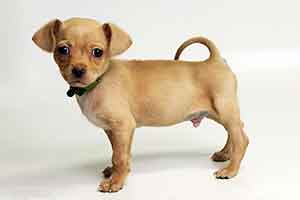 Puppies are small and adorable, but they all grow up to be adults and sometimes to be rather large adults. Find out how large in height and weight that puppy will become before you adopt. Larger dogs will require extra food, training and need an outdoor space to exercise and play. Some large dog breeds include great danes, english or bullmastiffs, great pyrenees and irish wolfhounds. Smaller breed dogs still need exercise, but could be content going on a couple walks during the day. Small breed dogs include chihuahuas, dachshunds, pugs, papillons and Yorkshire terriers.
Puppies are small and adorable, but they all grow up to be adults and sometimes to be rather large adults. Find out how large in height and weight that puppy will become before you adopt. Larger dogs will require extra food, training and need an outdoor space to exercise and play. Some large dog breeds include great danes, english or bullmastiffs, great pyrenees and irish wolfhounds. Smaller breed dogs still need exercise, but could be content going on a couple walks during the day. Small breed dogs include chihuahuas, dachshunds, pugs, papillons and Yorkshire terriers.
Your Lifestyle
 Your daily activities will tell you what breed of dog would be best for you. Are you active? Do you like to walk, jog or run for your daily exercise? You might consider a dog that is more active to join you with your exercise schedule such as an Australian shepherd, border collie, dalmatian or Siberian husky. Do you prefer to just cuddle on the couch? You should consider a smaller breed dog that is more subdued and enjoys cuddling next to you. Do you have young children or are you planning on bringing a child into your home? Consider a non-aggressive, mild tempered breed. These would include a beagle, golden retriever, boxer, pug or great dane.
Your daily activities will tell you what breed of dog would be best for you. Are you active? Do you like to walk, jog or run for your daily exercise? You might consider a dog that is more active to join you with your exercise schedule such as an Australian shepherd, border collie, dalmatian or Siberian husky. Do you prefer to just cuddle on the couch? You should consider a smaller breed dog that is more subdued and enjoys cuddling next to you. Do you have young children or are you planning on bringing a child into your home? Consider a non-aggressive, mild tempered breed. These would include a beagle, golden retriever, boxer, pug or great dane.
Coat/Grooming
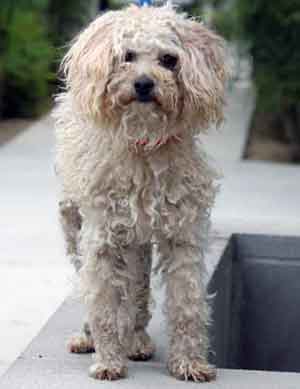 Dogs need to be groomed on a regular basis to stay healthy. Grooming can be as simple as brushing your dog’s coat or taking them a groomer to get clipped and fully groomed. All dogs shed, some shedding more than others. Some shed a lot all year around, some shed a few clumps every week and some shed only a little bit. Dogs with longer fur need more attention to brushing to make their coats clean and healthy. Brushing their coat routinely will prevent knotting and matting. Shorter hair breeds of dogs are easier to manage, but they may require extra protection in the hot or cold. Determining how much dog hair you’re willing to put up with and how much time, energy and money you can afford will help you choose whether you should adopt a short or long haired breed of dog.
Dogs need to be groomed on a regular basis to stay healthy. Grooming can be as simple as brushing your dog’s coat or taking them a groomer to get clipped and fully groomed. All dogs shed, some shedding more than others. Some shed a lot all year around, some shed a few clumps every week and some shed only a little bit. Dogs with longer fur need more attention to brushing to make their coats clean and healthy. Brushing their coat routinely will prevent knotting and matting. Shorter hair breeds of dogs are easier to manage, but they may require extra protection in the hot or cold. Determining how much dog hair you’re willing to put up with and how much time, energy and money you can afford will help you choose whether you should adopt a short or long haired breed of dog.
Male of Female?
When considering temperament between male or female, there is little to no difference. Male dogs tend to be more affectionate and loving, sometimes even attention demanding. Females can be just as loving but they like their solitude on occasion. Some believe female dogs are more nurturing toward children and therefore will protect them. Whereas male dogs may see children as a playmate and might get too playful with them. As far as training, female dogs are believed to more focused, which makes training easier. Male dogs have a tendency to act goofy and sometimes have a harder time concentrating. This may make training male dogs more difficult than female dogs.
How Old Are The Members Of Your Family?
If your children are under the age of seven, puppies five months or younger or toy-sized (under 15 pounds) would not be best suited for your household. Children that are under seven are usually not developmentally suited for young puppies or toy-sized dogs. Puppies have sharp teeth and toenails that could easily unintentionally scratch your children. At that point, the puppy becomes something, in the eyes of your child, to be feared rather than loved. Toy dogs are genetically fine boned and could get hurt if handled clumsily. A medium to large sized dog, over the age of five months would be the safer choice for your younger family. Since these dogs are larger in size, they are able to handle younger children playing with them. Regardless of any size, any interactions between your children and your pet should be monitored.
At the opposite end of the scale, if you have any elderly or physically challenged member in your household, there are certain criterias to consider as well. Getting a strong, rambunctious dog may not be the best choice. These types of dogs could unintentionally trip that member and they could fall, which could inflict injury.
Are You Financially Prepared?
Being a responsible owner means that you should get your dog vaccinated and checked by a veterinarian on a routine basis. Also, accidents and illnesses may occur with your pet which means an expense and trip to your vet. Being prepared for dog’s lifelong health needs is something we cannot stress enough. We also suggest spaying and neutering your dog. If you adopt from the CCSPCA, your dog will have been spayed or neutered as part of the adoption fee. To ensure your dog’s safety, we also recommending getting a microchip. This device allows your dog to be returned to you if he/she accidentally gets lost or loose. Again, if you adopt from the CCSPCA, your dog will already have a microchip implanted. Another option for being prepared is purchasing insurance for your pet. For more information about getting insurance for your dog, please visit the American Kennel Club’s website. Now that you have read and thought about what breed of dog would be best for you and your family, the search begins. We suggest you do more research on the specific breed you think would be best for you. A great resource for in-depth
Next Steps
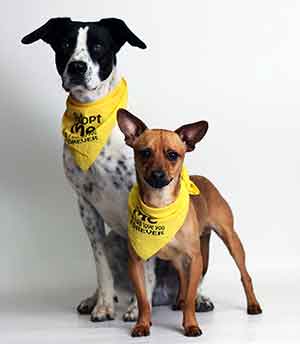 Now that you have read and thought about what breed of dog would be best for you and your family, the search begins. We suggest you do more research on the specific breed you think would be best for you. A great resource for in depth explanations of dog breeds is American Kennel Club. They have a full list of breeds with a breakdown of statistics and characteristics for each breed.
Now that you have read and thought about what breed of dog would be best for you and your family, the search begins. We suggest you do more research on the specific breed you think would be best for you. A great resource for in depth explanations of dog breeds is American Kennel Club. They have a full list of breeds with a breakdown of statistics and characteristics for each breed.
The CCSPCA has a wide variety of breeds to choose from. To find your next puppy or dog, check out our dogs available for adoption. All adoptions include the adoption fee, spay or neuter, microchip and registration, dog license (if applicable), vaccines (DHPP, Bordatella, Rabies), $750 of pet insurance and a free exam from one of our participating veterinary clinics.
